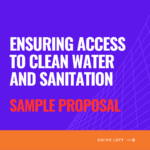Introduction: Sample Proposal on Ensuring Access to Clean Water and Sanitation for NGOs, Water is a fundamental resource, essential for sustaining life and ensuring the well-being of communities worldwide. Despite its undeniable significance, a significant portion of the global population faces an alarming crisis concerning access to clean water and proper sanitation facilities. This crisis not only jeopardizes individual health but also poses a formidable threat to the overall social, economic, and environmental stability.
At a global scale, billions of people grapple with inadequate access to clean water sources and sanitation facilities, impeding their ability to lead dignified lives. The repercussions of this crisis reverberate across communities, disproportionately affecting vulnerable populations. In both urban and rural settings, the lack of access to clean water perpetuates a cycle of poverty, ill health, and compromised educational opportunities.
This proposal aims to address the pressing issue of ensuring universal access to clean water and sanitation as a fundamental right for dignified living. By examining the current state of the global water and sanitation crisis, we can develop targeted strategies and interventions to create sustainable solutions that empower communities and foster a healthier, more prosperous world.
Sample Proposal on Ensuring Access to Clean Water and Sanitation for NGOs
I have provided a global context for the problem, when designing your proposal you need explain the local context as well, that your intervention will help the community that live in a particular geographical area where you are located.
Why is it important to access to clean water and sanitation for dignified living?
Access to clean water and sanitation is not merely a basic necessity; it forms the bedrock of dignified living, shaping the very fabric of human existence. The significance of ensuring universal access to these essential services extends far beyond the immediate benefits to health and well-being. It underpins the very essence of human dignity and lays the foundation for thriving, resilient communities. Here are key aspects highlighting the importance of access to clean water and sanitation:
- Preservation of Health: Clean water and proper sanitation are linchpins in preventing waterborne diseases and fostering good health. Access to safe drinking water reduces the incidence of water-related illnesses, contributing to the overall well-being of individuals and communities.
- Dignity and Privacy: Adequate sanitation facilities ensure personal privacy and dignity, particularly for women and girls. Access to clean and safe toilets is pivotal in promoting gender equality and safeguarding the dignity of individuals, creating environments that respect the rights and needs of all community members.
- Educational Opportunities: Reliable access to clean water and sanitation directly influences educational outcomes. Children, especially girls, are more likely to attend school regularly when facilities provide proper hygiene and sanitation. Improved attendance contributes to a more educated and empowered future generation.
- Economic Empowerment: Communities with access to clean water and sanitation can break free from the vicious cycle of poverty. The time saved from fetching water and the reduction in health-related expenses enable individuals to engage in productive activities, fostering economic empowerment and sustainable development.
- Environmental Sustainability: A sustainable approach to water and sanitation is crucial for environmental conservation. Proper waste disposal and wastewater management contribute to the preservation of ecosystems and the prevention of pollution, ensuring the long-term health of our planet.
- Community Resilience: Access to clean water and sanitation enhances the resilience of communities in the face of challenges such as natural disasters and public health crises. Well-equipped communities are better prepared to withstand and recover from adversities, ensuring the continuity of daily life and essential services.
As we recognize the intrinsic link between access to clean water, sanitation, and dignified living, it becomes imperative to prioritize and implement comprehensive strategies that address this fundamental human right. This proposal seeks to outline actionable steps and initiatives aimed at securing this right for all, fostering a world where every individual can lead a life of dignity and opportunity.
Sample Proposal on Ensuring Access to Clean Water and Sanitation for NGOs
Purpose of the Proposal
This proposal is designed to address the critical global water and sanitation crisis by advocating for and implementing targeted measures that recognize access to clean water and sanitation as fundamental rights essential for dignified living. Specifically tailored to our local context, the proposal aims to raise awareness, outline strategic interventions, mobilize resources, and empower communities. By integrating the unique challenges of our region, the proposal seeks to transform rhetoric into action, creating sustainable solutions that enhance the quality of life for individuals and communities in our area. Through collaborative efforts and community engagement, the proposal envisions a future where universal access to clean water and sanitation is not just an aspiration but a tangible reality, fostering resilience and prosperity.
Problem Statement
Statistics on the lack of access to clean water and sanitation worldwide
The global water and sanitation crisis is underscored by alarming statistics that highlight the pervasive nature of inadequate access to clean water and sanitation facilities. According to recent data from reputable international organizations such as the World Health Organization (WHO) and UNICEF:
- Lack of Clean Water:
- Approximately 2.2 billion people worldwide do not have access to safely managed drinking water services.
- In developing regions, nearly one in three people lacks access to basic drinking water services, leading to increased vulnerability to waterborne diseases.
- Sanitation Disparities:
- Globally, over 4.2 billion people lack access to safely managed sanitation facilities.
- In many low-income and marginalized communities, open defecation remains a stark reality for about 673 million people, contributing to the spread of diseases and compromising public health.
- Impact on Health:
- Lack of access to clean water and sanitation results in an estimated 829,000 deaths annually due to diarrheal diseases, with a disproportionate impact on children under the age of five.
- Waterborne diseases, such as cholera and typhoid, thrive in conditions where access to clean water and proper sanitation is limited.
- Educational Implications:
- Over 800 million school days are lost each year due to water-related diseases, underscoring the interconnectedness of water, sanitation, and education.
- Inadequate sanitation facilities in schools disproportionately affect girls, hindering their regular attendance and academic performance.
- Economic Consequences:
- The economic burden of inadequate water and sanitation is substantial, with estimates suggesting a global loss of $260 billion per year due to reduced productivity and increased healthcare costs.
- Vulnerable communities, already grappling with poverty, bear the brunt of these economic repercussions.
These statistics underscore the urgent need for comprehensive interventions to address the global water and sanitation crisis. By acknowledging the scale of the problem, this proposal aims to catalyze targeted actions that will contribute to a paradigm shift, ensuring that access to clean water and sanitation becomes a universal reality rather than an unmet aspiration.
Again, I have provided a universal or a global perspective on the problem. Bespoke the proposal as per your local context by inserting statistics that defines your context or the country you live in.
Sample Proposal on Ensuring Access to Clean Water and Sanitation for NGOs
Impact of Inadequate Water and Sanitation on Health, Education, and Overall Well-being:
The consequences of inadequate access to clean water and sanitation extend far beyond the immediate challenges of water scarcity. The pervasive impact on health, education, and overall well-being is profound, contributing to a cycle of poverty and compromised human development.
- Health Implications:
- Waterborne Diseases: In communities lacking proper sanitation and clean water, the prevalence of waterborne diseases such as cholera, dysentery, and typhoid significantly increases. This results in a higher incidence of illness, particularly among children, leading to preventable deaths and placing an additional burden on healthcare systems.
- Malnutrition and Stunted Growth: Inadequate water and sanitation contribute to malnutrition, compromising the growth and development of children. Chronic exposure to waterborne illnesses can lead to stunted growth, impairing physical and cognitive development.
- Educational Challenges:
- Impact on School Attendance: The lack of sanitation facilities, particularly in schools, disproportionately affects girls. The absence of private and hygienic toilets often leads to girls missing school during menstruation, contributing to a gender gap in educational attainment.
- Reduced Academic Performance: Water-related illnesses can result in frequent absenteeism and reduced cognitive functioning, impairing students’ academic performance and limiting their educational potential.
- Overall Well-being:
- Economic Burden: Families and communities burdened by water-related illnesses face increased healthcare costs and reduced productivity. The economic strain further perpetuates the cycle of poverty, hindering overall community well-being.
- Psychosocial Impact: The daily struggle for access to clean water and sanitation takes a toll on mental health and well-being. Stress, anxiety, and the constant threat of illness contribute to a diminished quality of life for individuals and communities.
- Gender Equality:
- Women’s Burden: In many societies, the responsibility for water collection falls disproportionately on women and girls. The hours spent fetching water detract from educational and economic opportunities, perpetuating gender inequalities.
- Safety Concerns: Lack of access to safe sanitation facilities exposes women and girls to safety risks, particularly during nighttime hours, further compromising their overall well-being.
- Community Resilience:
- Vulnerability to Disasters: Inadequate water and sanitation infrastructure heighten communities’ vulnerability to the impacts of natural disasters and climate change. The lack of resilient water and sanitation systems exacerbates the challenges faced during crises.
Recognizing the multifaceted impact of inadequate water and sanitation, this proposal underscores the urgency of implementing comprehensive solutions. By addressing the nexus between health, education, and overall well-being, we aim to break the cycle of poverty, empower communities, and lay the foundation for a healthier and more prosperous future.
Sample Proposal on Ensuring Access to Clean Water and Sanitation for NGOs
Scope of Work
Disparities in access based on Geographic Location, Socio-Economic Status, and Gender
The global water and sanitation crisis is compounded by stark disparities that disproportionately affect certain populations based on geographic location, socio-economic status, and gender. These disparities deepen existing inequalities, perpetuating a cycle of marginalization and hindering the achievement of universal access to clean water and sanitation.
- Geographic Disparities:
- Rural vs. Urban Disparities: Rural areas often face greater challenges in accessing clean water and sanitation compared to urban centers. Limited infrastructure, geographical remoteness, and lack of resources contribute to disparities in service provision, leaving rural communities more vulnerable.
- Climate Vulnerability: Climate change intensifies water scarcity in certain regions, exacerbating disparities. Vulnerable communities, particularly those in arid and low-lying areas, face heightened challenges in securing reliable access to clean water.
- Socio-economic Disparities:
- Poverty as a Barrier: Socio-economic status is a key determinant of access to clean water and sanitation. Impoverished communities, both in urban slums and rural settings, often lack the financial means to invest in infrastructure and face challenges in affording basic sanitation services.
- Informal Settlements: In urban areas, informal settlements frequently lack formal infrastructure, leading to inadequate water and sanitation facilities. Residents in these marginalized communities endure heightened health risks and limited access to essential services.
- Gender Disparities:
- Women and Water Collection: Women and girls bear a disproportionate burden in water collection, particularly in regions where water sources are distant. The time spent fetching water limits educational and economic opportunities for women and perpetuates gender inequality.
- Sanitation Challenges for Women: Inadequate sanitation facilities, especially in public spaces, pose challenges for women’s safety and dignity. The lack of private and hygienic toilets can deter women from participating fully in social and economic activities.
- Educational Disparities:
- Impact on School Attendance: In areas with limited water and sanitation infrastructure, children, especially girls, face barriers to regular school attendance. Lack of proper facilities in schools contributes to absenteeism and hinders educational progress.
- Educational Attainment: The interplay of socio-economic and gender disparities often results in lower educational attainment for girls, perpetuating a cycle of inequality and limiting their future opportunities.
- Health Inequities:
- Healthcare Access: Disparities in access to clean water and sanitation contribute to health inequities, with marginalized populations experiencing higher rates of waterborne diseases. Limited access to healthcare further exacerbates the impact on vulnerable communities.
Acknowledging and addressing these disparities is crucial for the success of any intervention. This proposal is committed to designing inclusive strategies that consider the specific needs of marginalized communities, ensuring that access to clean water and sanitation becomes a universal reality, irrespective of geographic location, socio-economic status, or gender.
Objectives of Project (Sample Proposal on Ensuring Access to Clean Water and Sanitation for NGOs)
| Objective One: |
A. Ensure Universal Access to Clean Water and Sanitation: This objective aims to eliminate disparities and ensure that all communities, regardless of location or socio-economic status, have equal and consistent access to clean water and sanitation facilities, recognizing these as fundamental rights for dignified living. |
| Objective Two: |
B. Improve Hygiene Practices and Awareness: Focusing on education and community engagement, this objective seeks to enhance hygiene practices and awareness. By fostering a culture of cleanliness and imparting knowledge about proper hygiene, the goal is to prevent the spread of diseases and promote overall well-being. |
| Objective Three: |
C. Reduce Waterborne Diseases and Related Health Issues: This objective targets the reduction of waterborne diseases by implementing measures to enhance water quality and sanitation. The aim is to alleviate the burden of preventable illnesses, particularly in vulnerable populations, leading to improved public health outcomes.
|
| Objective Four: |
D. Promote Sustainable Water Management Practices: With an emphasis on environmental responsibility, this objective seeks to promote sustainable water management practices. By encouraging efficient use of water resources, minimizing pollution, and embracing eco-friendly approaches, the goal is to ensure the long-term availability of clean water for present and future generations. |
Sample Proposal on Ensuring Access to Clean Water and Sanitation for NGOs
How the problem can be addressed?
Proposed Solutions and intervention that can be incorporated the proposal. The major focus will be on three broad categories (A. Infrastructure Development, B. Community education and Empowerment & C. Policy Advocacy)
Infrastructure development
- Water Supply Systems: Implement robust water supply systems that include the creation and enhancement of reliable infrastructure for sourcing, treating, and distributing clean water. This involves investing in well-maintained pipelines, reservoirs, and water treatment facilities to ensure consistent access to safe drinking water for all communities.
- Sanitation Facilities: Focus on developing adequate sanitation facilities, including the construction of hygienic toilets and sewage systems. This requires a comprehensive approach, addressing both urban and rural contexts, to provide communities with essential facilities that safeguard privacy, dignity, and public health.
- Wastewater Treatment Plants: Establish and upgrade wastewater treatment plants to responsibly manage and treat sewage. This solution involves implementing efficient and environmentally friendly technologies to minimize pollution, protect water bodies, and ensure the safe disposal or reuse of treated wastewater, contributing to sustainable water management.
Community Education and Empowerment
- Hygiene and Sanitation Awareness Programs: Implement educational programs to raise awareness about proper hygiene and sanitation practices within communities. These initiatives aim to empower individuals with knowledge, promoting healthier living conditions and preventing the spread of waterborne diseases.
- Training on Water Conservation Practices: Conduct training sessions to educate communities on effective water conservation practices. This involves empowering individuals to optimize water usage, reduce wastage, and contribute to sustainable water management, fostering a sense of responsibility for water resources.
- Community-Led Initiatives for Water Resource Management: Facilitate community-led initiatives for water resource management, encouraging active participation in the protection and preservation of local water sources. Empowering communities to take ownership of sustainable water practices ensures long-term resilience and responsible use of water.
Sample Proposal on Ensuring Access to Clean Water and Sanitation for NGOs
Policy Advocacy Solutions
- Collaboration with Local and National Governments: Foster partnerships and collaboration with local and national governments to align efforts, share resources, and jointly address water and sanitation challenges. This involves engaging in constructive dialogue to ensure coordinated, government-supported initiatives.
- Lobbying for Policy Changes to Prioritize Water and Sanitation: Advocate for policy changes at various levels of governance to prioritize and allocate resources for water and sanitation initiatives. Through strategic lobbying efforts, the goal is to influence policy decisions that enhance the legal and financial support for essential infrastructure and services.
- Establishing Regulatory Frameworks for Sustainable Water Management: Work towards the establishment of regulatory frameworks that promote sustainable water management practices. This includes developing policies that address water quality standards, efficient resource allocation, and environmental conservation, contributing to responsible and resilient water systems.
Budget (Broad Categories of Budget allocation under specific heads, now you need to prepare the calculation in an excel sheet)
A. Cost Estimation for Infrastructure Development:
- Water Supply Systems: Estimated cost includes the construction and maintenance of pipelines, reservoirs, and treatment facilities. Budget allocation should cover the sourcing of clean water, treatment processes, and the establishment of a reliable distribution network.
- Sanitation Facilities: Budget covers the construction of toilets, sewage systems, and waste disposal infrastructure. Additionally, funds are allocated for awareness campaigns to promote proper usage and maintenance of sanitation facilities.
- Wastewater Treatment Plants: Cost estimation involves the construction and upgrading of treatment plants, implementation of advanced technologies, and ongoing maintenance to ensure efficient and environmentally responsible wastewater management.
B. Budget Allocation for Educational and Awareness Programs:
- Hygiene and Sanitation Awareness Programs: Funds are allocated for the development and implementation of educational materials, workshops, and community outreach initiatives to raise awareness about proper hygiene and sanitation practices.
- Training on Water Conservation Practices: Budget covers the design and delivery of training programs, creation of educational materials, and community workshops focused on water conservation practices.
- Community-Led Initiatives for Water Resource Management: Allocation includes resources for organizing community engagement events, developing educational resources, and facilitating initiatives that empower communities to actively manage local water resources.
Sample Proposal on Ensuring Access to Clean Water and Sanitation for NGOs
C. Funding Sources, Including Potential Grants, Partnerships, and Community Contributions:
- Grants: Seek funding from international organizations, governmental bodies, and non-profit foundations that support water and sanitation projects. This includes applying for grants that align with the proposed infrastructure development, educational programs, and policy advocacy initiatives.
- Partnerships: Collaborate with governmental agencies, non-profit organizations, and private sector entities to secure financial and in-kind support. Partnerships can enhance the project’s reach, expertise, and sustainability.
- Community Contributions: Encourage and facilitate community involvement by seeking financial contributions, volunteerism, and in-kind support. Empowering communities to actively participate in the initiatives fosters a sense of ownership and long-term commitment.
Developing a comprehensive budget requires a detailed breakdown of costs for each aspect of the project, ensuring that financial planning aligns with the goals of infrastructure development, educational programs, and sustainable water management practices.
Monitoring and Evaluation:
- Key Performance Indicators (KPIs) for Success:
- Infrastructure Development:
- Percentage increase in households with access to clean water and sanitation.
- Reduction in waterborne diseases and related health issues.
- Compliance with water quality standards and sanitation facility guidelines.
- Educational and Awareness Programs:
- Increased hygiene and sanitation knowledge within the community.
- Number of participants engaged in water conservation training.
- Community-led initiatives successfully implemented for water resource management.
- Policy Advocacy:
- Number of policy changes or additions prioritizing water and sanitation.
- Improved regulatory frameworks for sustainable water management.
- Collaboration levels with local and national governments measured through MOUs and joint initiatives.
2. Regular Progress Assessments:
- Infrastructure Development: Conduct regular site visits to assess construction progress, adherence to timelines, and budget utilization. Periodic reviews of water quality and sanitation facility functionality.
- Educational and Awareness Programs: Evaluate participation rates in workshops, training sessions, and community engagement events. Conduct surveys to measure changes in knowledge and behavior regarding hygiene, sanitation, and water conservation.
- Policy Advocacy: Regularly review policy landscapes and track any changes or additions related to water and sanitation. Assess the level of engagement and collaboration with local and national governments through progress reports and meetings.
Sample Proposal on Ensuring Access to Clean Water and Sanitation for NGOs
3. Feedback Mechanisms from the Community:
- Infrastructure Development: Establish community feedback sessions to address concerns related to construction disruptions and gather insights on facility usage.
- Educational and Awareness Programs: Use surveys, focus group discussions, and community meetings to collect feedback on the effectiveness of educational programs and community-led initiatives.
- Policy Advocacy: Facilitate town hall meetings and forums to gather community opinions on policy changes and regulatory frameworks. Utilize online and offline platforms for continuous feedback on the impact of policy advocacy efforts.
Effective monitoring and evaluation rely on a combination of quantitative and qualitative data, ensuring a comprehensive understanding of project progress and community engagement. Regular assessments and feedback mechanisms provide valuable insights for adjustments and improvements throughout the implementation process.
Sustainability
Sustainability refers to the capacity of a project or initiative to endure and thrive over the long term while minimizing negative impacts on the environment, society, and economy. Achieving sustainability involves balancing present needs without compromising the ability of future generations to meet their own needs. Key considerations include environmental stewardship, social equity, economic viability, and community empowerment. Sustainable practices ensure the resilience and lasting impact of projects, fostering a harmonious coexistence between human activities and the planet’s finite resources.
As implied by its title, the proposal presented here serves as a template, and there is ample room for refinement or customisation based on your unique needs assessment.
Feel free to adjust or tailor it to align closely with your specific requirements.
Sample Proposal on Ensuring Access to Clean Water and Sanitation for NGOs
On a closing note, this proposal lays the groundwork for a transformative endeavor to ensure universal access to clean water and sanitation. The key lies not just in addressing immediate challenges but in fostering sustainable practices, empowering communities, and advocating for policies that stand the test of time. By embracing a holistic approach that intertwines infrastructure development, education, and policy advocacy, we pave the way for a future where every individual enjoys the dignity of clean water, improved health, and enhanced well-being. Let us embark on this journey hand in hand, cognizant of the responsibility we bear for our communities and the planet. Together, we can turn this vision into a reality, leaving a lasting legacy for generations to come.
Related Good Reads, Link
Hey, STEAL our Best Premium Content For Absolutely Free, Check Out the Links below
HOPE these will add value to your existing skills and knowledge
Our information bears no cost (it’s absolutely FREE), don’t let valuable information slip away.
Join our community of avid readers who are always in the know. Subscribe to our website; stay connected and engaged with the latest news, trends, and developments by subscribing today.
(PUSH the bell ICON)
Leverage the power of knowledge to propel your organization to new heights. Don’t miss out to explore our content
- Latest Funds for NGOs,
- NGO Jobs
- Resources (Helpful Guides and Courses)
- Premium Resources
- NGO related articles
Empowering Humanity through Funds, Resources and Collective Action
Sharing is Appreciated









